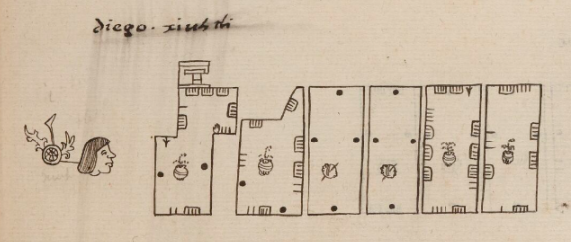Xiuhtli (Verg9r)
This black-line drawing of the compound glyph for the personal name Xiuhtli (“Comet,” attested here as a man’s name) shows a frontal view of a turquoise (xihuitl, a near homophone) mosaic with two flames coming out of it, which suggests it is meant to be a comet. Between the two flames is an agricultural digging stick [the huictli), which provides the phonetic for the "hui" of xihuitl.
Stephanie Wood
This popular name, Xiuhtli, is linked to the religious calendar of years, because it was a name given to boys born during the time of the binding ceremony at the end of every fifty-two year cycle. When it relates to the ending of a 52-year cycle, the name Xiuhtli may contain the Xiuh- that is the stem for xihuitl (year). Turquoise (xihuitl, only distinguishable from the word for year when in context) is also a near homophone for comet (xiuhtli), which makes the mosaic a phonogram. Apparently, the turquoise mosaic pieces, the artist/writer hoped, would bring to mind the name Xiuhtli. There are other names in this collection that similarly use the turquoise pieces, such as Xiuhnel, the name of the morning star and a cloud serpent in the Nahua religion.
diego. xiuhtli
Diego Xiuhtli
Stephanie Wood
1539
Jeff Haskett-Wood
comets, cometas, years, años, tiempo, time, turquoise, tools, turquesa, herramientas, agricultura, fuego, xiuhpohualli, xihuitl, nombres de hombres

Xiuh(tli), comet, year, or a boy's name given at end of 52-year calendrical cycle, https://nahuatl.wired-humanities.org/content/xiuhtli
xihui(tl), turquoise, year, comet, herb, https://nahuatl.wired-humanities.org/content/xihuitl
hui(ctli), digging stick, https://nahuatl.wired-humanities.org/content/huictli
El Cometa
Stephanie Wood
Codex Vergara, folio 9r, https://gallica.bnf.fr/ark:/12148/btv1b84528032/f25.item.zoom
The non-commercial reuse of images from the Bibliothèque nationale de France is free as long as the user is in compliance with the legislation in force and provides the citation: “Source gallica.bnf.fr / Bibliothèque nationale de France” or “Source gallica.bnf.fr / BnF.” We would also appreciate a citation to the Visual Lexicon of Aztec Hieroglyphs, https://aztecglyphs.wired-humanities.org/.




